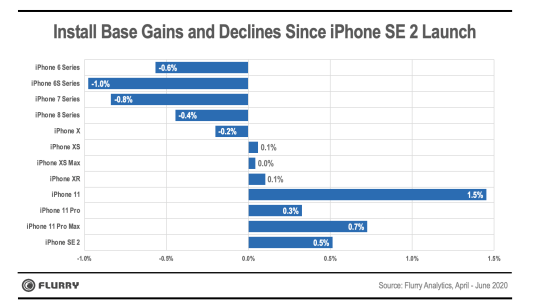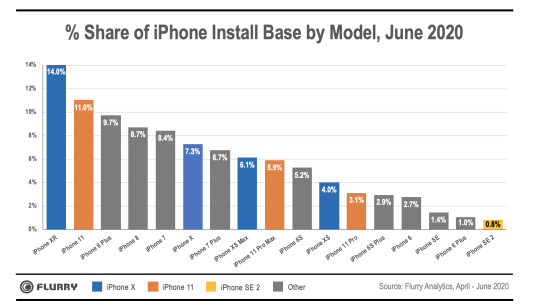Following the Fall 2019 launch of the iPhone 11 series—the most expensive and advanced iPhones to date—Apple launched the value-priced 2nd generation iPhone SE on April 24, 2020. The popular 1st generation iPhone SE was offered in 2016 as a less expensive alternative to the then flagship iPhone 6S and 6S Plus devices. And the launch of the second generation version follows the same playbook by offering strong value at a low price point. In this report, Flurry looks at how well the launch of the 2nd generation iPhone SE (aka iPhone SE 2) fared in the United States.
With four years between launches, shipping the follow-up iPhone SE 2 seems timely. The smartphone starts at just $399—a less expensive alternative to the iPhone 11 series, priced between $699 to $1,449 depending on the device and storage. With some consumers preferring the compact size of the original iPhone SE, Apple kept the iPhone SE 2 much smaller than current alternatives with a 4.7” display. It also uses the home button, popular among many consumers. To keep costs down, while still maintaining performance, the iPhone SE 2 features the same A13 Bionic chip used in the iPhone 11 as well as the iPhone XR camera, considered the best single camera system made by Apple.
At the same time, this launch faces the unprecedented challenge of entering the market during the global COVID-19 pandemic. While a lower price-point could appeal to consumers during economic uncertainty, significant unemployment rates and the closure of Apple retail stores between March 13 and May 11 very likely impacted the launch. And, as we reported earlier, we have observed an overall slowdown in new iPhones activated in the United States since March.
As a mobile app analytics provider, Flurry sees app activity in over 1 million mobile applications across 2 billion smartphone devices each month, giving us unique insights into smartphone adoption. We start our analysis by reviewing the change in share for all Apple devices in the market since the iPhone SE 2 launch on April 24.

The chart above illustrates how Apple drives device replacement cycles. As new iPhones are released, older models decrease in share while more recent models tend to increase in share. The iPhone SE 2 captured a half a percentage point of the iPhone install base since launching. The iPhone XR, on the other hand, the darling of Apple’s lineup entering the 2019 Holiday season, increased its share of install base during the same time period by only 0.1%. This could indicate the iPhone XR’s reign as Apple’s most popular device could be coming to an end, making way for the iPhone SE 2. On the high-end, we note the strong growth of the iPhone 11 and the iPhone 11 Pro Max, adding 1.5% and 0.7% of the install base, respectively.
Next, let’s review the current install base for all Apple iPhones as of June 11, 2020.

The iPhone XR has the largest share of the iPhone install base with 14%. However, we expect the iPhone 11 to overtake the iPhone XR by the end of the year for two reasons. First, the iPhone 11’s adoption rate is nearly 15 times greater. Second, we expect the iPhone SE 2, which costs a third less, to further slow the growth of the more budget-oriented iPhone XR.
While the iPhone SE 2 has a current 0.8% share among iPhone devices, we expect adoption to accelerate, especially as retail stores start to reopen. With diminished retail support, it’s reasonable to expect the device is off to a slower start. Additionally, with economic uncertainty caused by the COVID-19 pandemic, the more affordable iPhone SE 2 may appeal to customers who might have otherwise opted for a pricier model.
Apple has also introduced more subscription services in recent years as an added revenue stream. Tuned for a better video experience than its predecessor, the less expensive iPhone SE 2 may also drive more subscriptions to Apple Music or Apple TV. Either way, we expect the iPhone SE 2 to drive upgrades among more budget conscious iPhone 6, 7 and 8 series owners, as well as drive device replacement among remaining 1st generation SE users. Finally, as an attractive low price alternative to Android customers, the iPhone SE 2 could convince some Android customers to make the switch to iOS. As always, we’ll keep an eye on adoption rates and report interesting findings.
iPhone is a trademark of Apple Inc., registered in the U.S. and other countries.
Flurry’s blog is an independent blog and has not been authorized, sponsored, or otherwise approved by Apple Inc.